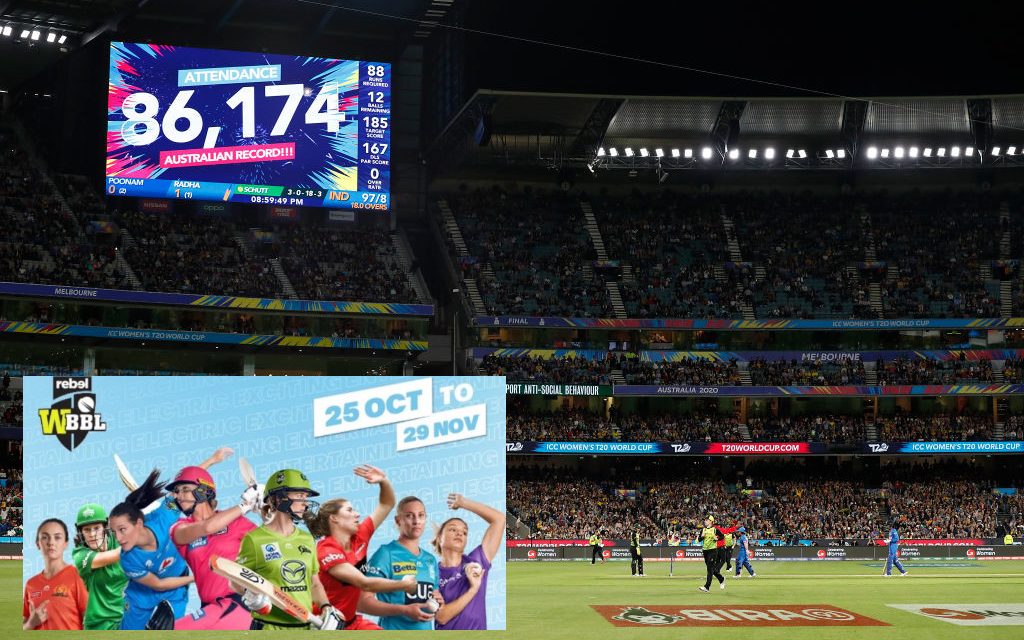A packed MCG watches the women’s T20 World Cup final between Australia and India last March. Photo: GETTY IMAGES
I am Catwoman.
I am nine years old, and this is serious business.
I’m wearing a shiny tracksuit, and I’m squatting on a perfectly manicured lawn a few feet away from the clothesline. The ball hits the metal pole at speed and rebounds at right angles, flying past my left side. I react quickly – shifting my weight and diving after it, arm outstretched.
Thump. The beautiful, clean noise of the tennis ball hitting and sticking onto my palm.
I lie on the ground, my hand squeezing the yellow, slightly furry ball as I hold it aloft. “Hoooooooooooowzat!!!” I spring to my feet, toss the ball high into the sky and finish the routine with a soccer-inspired lap of the lawn, high-fiving the bottlebrush on the way through, giddy on the simple pleasure of catching a tennis ball – albeit, one that had no right to be caught.
– Extract from “Breaking The Mould” (Angela Pippos, 2017)
It’s been a shitshow of a year, especially for those of us who call Melbourne home. Despite this, 2020 has given me something that can never be tarnished or ruined, can never be taken away, or packaged up and sent to the Gabba. It’s given me a memory I will treasure, a gleaming nugget of gold that will continue to sparkle long after this Truman Show-esque year has been consigned to the history books.
March 8, 2020. International Women’s Day.
The Women’s T20 World Cup final.
86,174 at the MCG.
All my worlds collided that night. Vindication for two decades of telling anyone who would listen that we must invest in girls and women. Girls deserve the same opportunities and pathways in sport as boys. That should be our starting point.
It’s a moral argument.
As Katy Perry was strutting her stuff pre-game with giant feminist symbols all around her, I thought about how we got here, how we got to this moment of a near-full MCG for a women’s cricket match.
I thought about Betty Wilson choosing cricket over marriage because a woman couldn’t have both; the unfairness of women being excluded from the Long Room until 1984; the pain on women’s football pioneer Debbie Lee’s face when she told me her story of shame and embarrassment because she wanted to play footy; the ignominy of Kathrine Switzer having to hide her sex to compete in the 1967 Boston Marathon – historically, sport hasn’t rolled out the welcome mat for women.
But things could not have felt any more different that night at the MCG. The juxtaposition was stark and glorious.
PLEASE HELP US CONTINUE TO THRIVE BY BECOMING AN OFFICIAL FOOTYOLOGY PATRON. JUST CLICK THIS LINK.
As the dominant summer sport in Australia, men’s cricket has enjoyed all the trappings – extensive media coverage, juicy contracts, rusted-on sponsors and glorification. Up until quite recently, women who chose to play cricket were thought to have simply lost their bearings on the way to the netball court. They were relatively unknown, despite women’s cricket having a vibrant history in Australia.
Founding mother Lily Poulett-Harris, a Tasmanian, captained the Oyster Cove Ladies Cricket Club in the league she created in 1894.
By the following year, the ladies’ competition was turning heads, as noted by a sports journalist in the Mercury on 2 December 1895: “(Interest in cricket) seems to be growing, and extending to the weaker sex, who often have a quiet match upon a romantic little plateau on the Domain immediately beyond the upper cricket ground”.
These days you can cheer on members of the “weaker sex” in the world’s best women’s cricket league, the WBBL.
WBBL 06 is a different-looking season with 59 games over 35 days in a Sydney hub. It began last Sunday with a Barefoot Circle by Indigenous players and captains to acknowledge the traditional owners of the land, and strongly show their commitment to reconciliation. It was a poignant, no fuss, player-led stand against racism.
The WBBL has been a gamechanger for women’s cricket in Australia and globally. It attracts the world’s best players from New Zealand, England, South Africa and the West Indies. It has evolved into a standalone tournament and the number of games broadcast on TV continues to grow.
That 86,174 didn’t spring from nowhere.
Seeing women athletes on the WBBL stage sends the message to everyone that girls and women belong in cricket, but it goes deeper than that.
One of the reasons teenage girls drop out of sport is because they can’t see female role models and they can’t see a pathway to elite sport. Thankfully, this is changing. Visibility of sportswomen also challenges gender stereotypes and shows girls that you don’t have to be drawn into the feminine stereotype that’s been constructed for you – you can create your own version of what it means to be a girl.
These days I need a twice-weekly Pilates class to keep me agile, but I still love, and can still pull off, a classic catch, whether it be in the park, the backyard or the kitchen (as a rogue mini-bocconcini ball rolls off the bench). That feeling of exhilaration that goes with it never fades.
While the younger me pretended to be Catwoman in the garden as my brother and I played our catching practice game, girls today don’t have to fantasise about being any superhero – they can be Meg Lanning, Alyssa Healy or Megan Schutt.
March 8, 2020, was a day for the true believers who knew a packed stadium for women’s sport was possible.
All that was needed was the will to do it.












